855-928-8500 | Mon-Fri: 9AM-5PM EST | FREE Shipping on orders over $49
- Schneider Square D
- Eaton Cutler-Hammer
- Siemens / ITE
- Crouse Hinds
- Allen-Bradley
- GFCI (Ground Fault)
- AFCI (Arc Fault)
- Surge Protectors
- Molded Case
- Overload Relays
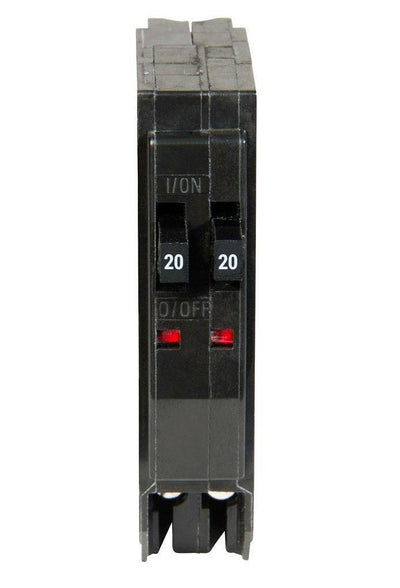
- Circuit Breakers
- Motor Control
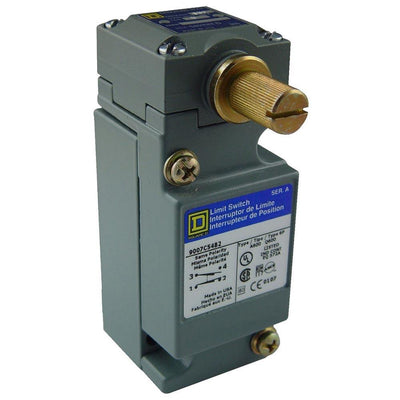

Confirm your age
Are you 18 years old or older?
Come back when you're older
Sorry, the content of this store can't be seen by a younger audience. Come back when you're older.
THQB32050ST1 - GE - 50 Amp Shunt Trip Circuit Breaker
Bolt-on - 50 amp - 3 pole - 240 volt.
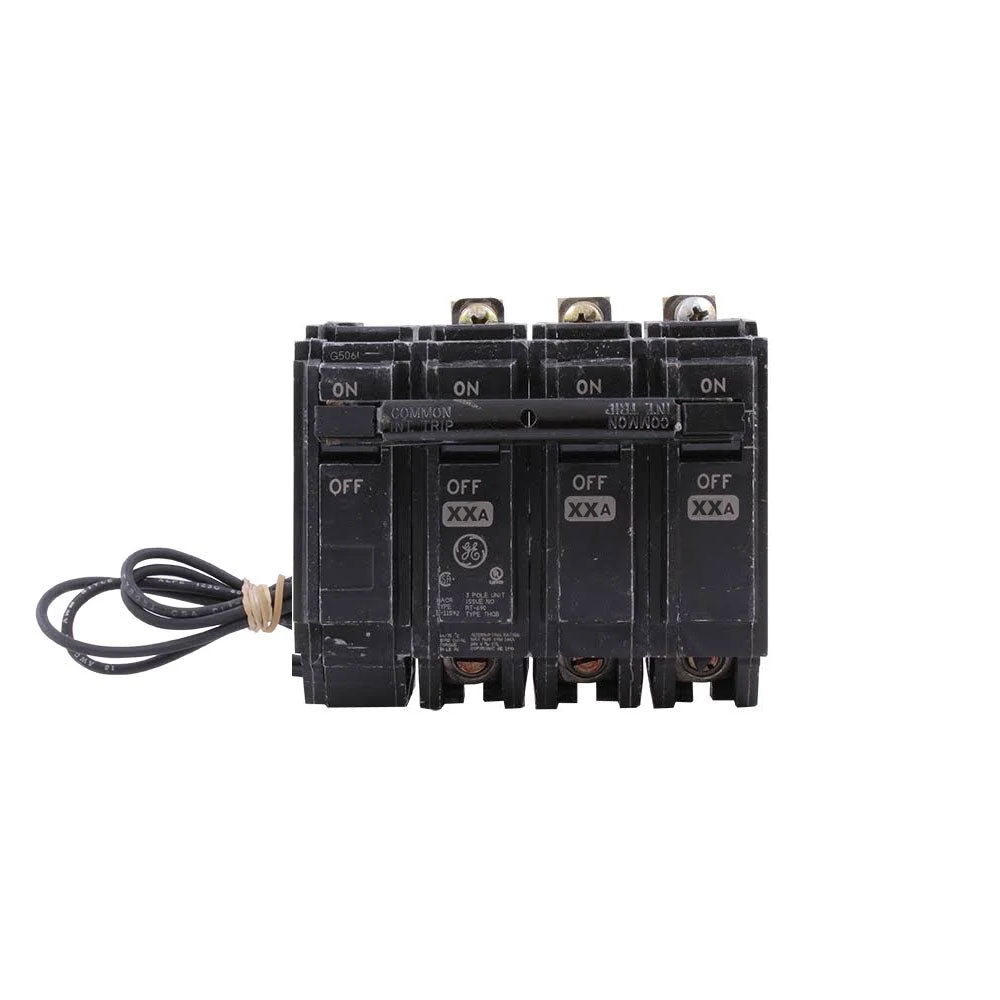
Images are for reference only
- In stock and ready to ship
- Inventory on the way
Returns are easy
You may return items within 30 days of delivery for a refund.
View our return policy
FREE Shipping on orders over $49.
Simply Breakers offers one to five day delivery in the United States. The variation depends on the chosen shipping speed and the warehouse location for the product(s).
Same Day Shipping
We strive to ship out your items within one business day.
In rare circumstances, Simply Breakers may reserve up to 5 business days to complete shipment. Feel free to contact us if your order is time sensitive.
Simply Breakers provides a comprehensive 1-year warranty on both new and reconditioned products. Rest assured, all products are authentic OEM (original equipment manufacturer).
THQB32050ST1 - GE Molded Case Circuit Breaker
This General Electric (GE) THQB series three pole 50 ampere bolt-on molded case circuit breaker with shunt trip has a maximum voltage rating of 240V, trip type thermal magnetic common trip and standard interrupting rating of 10 kiloampere at 240V. It features an internal common trip with factory installed shunt trip thermal magnetic (LI) Long-Time and Instantaneous trip functions and load side lug terminals.
Specifications:
- Trip Style: Non-Interchangeable
- Frame Type: Q-Line
- Amperage: 50 A
- System Voltage: 120 Vac, 120/240 Vac, 240 Vac
- Trip Function: LI
- Continuous Current Rated: Standard
- 120 Vac Interrupting Rating: 10 KAIC
- 120/240 Vac Interrupting Rating: 10 KAIC
- 240 Vac Interrupting Rating: 10 KAIC
- Suitable for Reverse Feed: Yes
- Long Time: Fixed
- Instantaneous: Fixed
- Protective Relays: No
- Current Metering: No
- Special Markings: HACR
- GSA Compliance: No
- Authentic General Electric Product
This site is protected by reCAPTCHA and the Google Privacy Policy and Terms of Service apply.
Customer Reviews
Great delivery and the product was as detailed. Greast Purchase
Simply Breakers and (David) provided great customer service. I initially called requesting a return because I found another retailer with better prices. David acknowledged my price difference promptly and price matched the other retailer. Highly recommend supporting this company.
Works great, as described. Matches all of the other breakers in the panel. Easy installation and simply fits perfectly. (In the picture I am pointing to it with a screw driver)
hard to find

Join our mailing list and recieve special offers.
- --> Login or Sign Up
- Canadian Dollar
- Login or Sign Up -->
We will be closed Thursday November 25th and Friday November 26th For Thanksgiving. We will resume fulfilling orders on Monday Nov 29th

- Circuit Breakers
BAB2050S Eaton 2 Pole 50 Amp Shunt Trip Breaker
- All Circuit Breakers
- Connecticut Electric
- Cutler-Hammer Circuit Breakers
Eaton | Cutler-Hammer
- Federal Pacific
- Merlin Gerin
- Westinghouse
- Zinsco Circuit Breakers
- All Enclosures for Circuit Breakers
- EATON Circuit Breaker Enclosures
- GE Circuit Breaker Enclosures
- Square D Circuit Breaker Enclosures
- Power Supply
- All Accessories
- Rating Plugs
- Auxiliary Contacts
- Lock-Offs/Hasps
- Shunt Trips
- Undervoltage Release
- All Motor Control
- All Contact Kits Renewal/Replacement
- Cutler-Hammer Renewal Contacts
- Square D Renewal Replacement Contact Kits
- GE Contact Renewal Kits
- Allen-Bradley
- Heaters Overloads
- Replacement Coils
- All Magnetic Starters
- Allen Bradley
- Cutler-Hammer
- All Breaker Panels
- All Electric Panel Boards
- Meter Mains
- Weather Proof Enclosures
- Load Centers
- All Busway Plugs
- General Electric
- Fusible Switches
- All Safety Switches
- Cutler Hammer
- All Mounting Hardware Kits
- All Buttons and Switches
- All General Electric
- GE Industrial
- Safety Plus
- All Fittings
- Conduit Bodies
- Explosion Proof
- All Pullout Fusible Disconnects
- Transformers
- Shop by Brand
- Square D by Schneider Electric
- Federal Pacific | Federal Pioneer
- Cooper Crouse-Hinds
- View all Brands

Share This Article
Warranty Information
- Custom Field #1
- Custom Field #2
- Similar Products
Product Description
- Shunt Trip Circuit Breaker
- 120VAC Shunt Accessory Installed
- Thermal Magnetic Breaker
- 14 to 4 AWG AL/CU Wire
- 120/240V Rated Breaker
- Bolt-On Mounting
- 10,000 AIC Interrupting
- 2 Pole Unit
- QUICKLAG[R] BRAND
- Pigtail connection for shunt
- Eaton/Cutler-Hammer
- New or Re-certified
Product Videos
Custom field, product reviews.
- Recommended
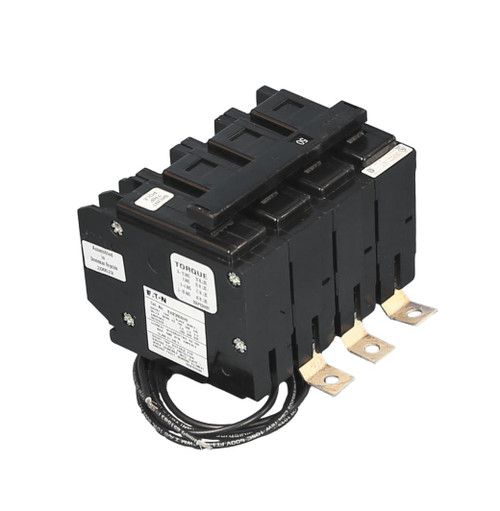
BAB3050HS Eaton 3 Pole 50 Amp Circuit Breaker with Shunt Trip

BAB2015S Eaton 2 Pole 15 Amp Shunt Trip Breaker

BAB2100S Eaton 2 Pole 100 Amp Shunt Trip Breaker
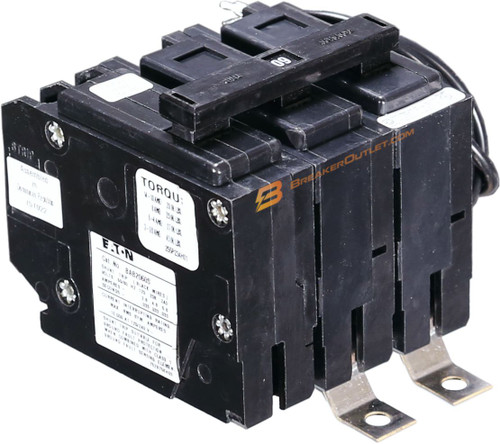
BAB2020S Eaton 2 Pole 20 Amp Shunt Trip Breaker

BAB2060S Eaton 2 Pole 60 Amp Shunt Trip Breaker
- svg]:stroke-primary"> 826K
- svg]:stroke-primary"> 622K
- svg]:stroke-primary"> 246K
- svg]:stroke-primary"> 45K
Why Is My Circuit Breaker Tripping? 4 Potential Problems and Solutions
By: Glenda Taylor , Bob Vila , Evelyn Auer
Updated on Dec 21, 2023 8:55 PM EST
6 minute read
Photo: istockphoto.com
We may earn revenue from the products available on this page and participate in affiliate programs. Learn More ›
Q: Every few hours—sometimes minutes!—my living room and one side of my kitchen lose electrical power. I’ll check the breaker panel and, sure enough, a circuit breaker has tripped…again. Should I call an electrician, or is there a simple DIY fix I can try first?
A: While it’s frustrating when a circuit breaker keeps tripping, they are important safety mechanisms. Designed to shut off the electrical current when something goes wrong, circuit breakers are one of the best ways of protecting a home from an electrical fire. “When a circuit breaker trips, typically it is because we use too much electricity, which causes it to overload and turn off,” says Christopher Haas, expert electrician and owner of Haas & Sons Electric in Millersville, Maryland. For those who need an electrical panels 101 refresher course or aren’t sure how to reset circuit breakers, each breaker has an on/off switch and controls a separate electrical circuit in the home. When a breaker trips, its switch automatically flips “off,” and it must be manually turned back on to restore electricity to the circuit. For those wondering, “Is it dangerous if a circuit breaker keeps tripping?” the answer is that it can be, depending on the source of the problem. An electrician can ultimately deal with the root issue, but a little sleuthing will reveal whether it’s something that’s easily remedied.
In many cases, the cause of a circuit breaking tripping is an overloaded circuit.
A circuit overloads when more electrical current is being drawn through the wires than they can handle, tripping the circuit breaker. If this happens, there may be a few additional signs:
- Buzzing noises coming from outlets
- Devices charging slowly
- Electrical outlets not working
- Flickering lights
- Scorch marks on outlets and light switches
If a circuit breaker keeps tripping in one room, homeowners can test for circuit overload by turning off all the switches in the affected area and unplugging all appliances and devices. After the breaker is flipped back on, the devices can be turned back on one at a time, with homeowners waiting a few minutes in between to see if the circuit remains on. If the breaker trips before all the appliances are turned on, the experiment can be repeated, this time turning them on in a different order. It may be necessary to do this several times to find out how many appliances can be operated at once before the circuit overloads.
“As a short-term solution, you can unplug unnecessary appliances to prevent tripping circuit breakers. You may still get some trips, but you can limit them by unplugging devices that you don’t need to use,” advises Dan Mock, vice president of operations at Mister Sparky , an electrical company with 90 locations in the U.S. The best long-term solution, however, is to pay an electrician for the cost to rewire the house and add additional circuits. The cost to replace an electrical panel is about $1,274 on average.
Other times, the issue may be caused by a short circuit.
A “short” circuit means that two wires that should not be coming into contact are inadvertently touching, triggering a sudden surge of electricity through the wires. A short can occur in an outlet, a switch, or within an appliance if wires are loose or have been chewed through by mice or pets. Some signs of a short circuit include:
- Popping sounds
- Discolored outlets or switches
- Burning smells
Testing to see if an appliance has a short is similar to testing for an overloaded circuit. When an appliance that has a short in its wiring is turned on, it will immediately trip the circuit. Homeowners can also try plugging it into an outlet in a different room. If the breaker for that room trips, there’s a short in the appliance (if it’s unclear what breaker goes to what room, the breaker can be identified with one of the best circuit breaker finders ). Electrical shorts can be a major fire hazard, so it’s a good idea to call a licensed electrician for this circuit breaker repair. It’s wise to stop using the outlet or appliance until a pro takes care of the problem.
Another potential cause of a circuit breaker tripping is a ground fault.
A ground fault occurs when the electricity running through a home’s wiring diverts from the wiring loop and travels to the ground, usually due to faulty wiring or water infiltration in an outlet or switch box. Water is a conductor, which is why walking through puddles is often listed as something not to do in a power outage in case of downed power lines. Once water makes contact with wires, electricity can jump from the wiring loop and follow the water trail. This creates a surge in electricity leading to a tripped circuit breaker. If a person comes in contact with the electricity that is on its way to the ground, this can result in electrocution. Homeowners may notice a few signs of a ground fault, including:
- Tripped GFCI (ground fault circuit interrupter) outlets;
- A burning smell coming from an outlet; and
- Lights flickering.
Newer electrical breakers have features designed to protect against the danger of ground faults. According to Haas, “Ground fault breakers sense electricity going to earth as opposed to going through the wires of the circuit. You’ll find [these] for bathrooms, kitchens, garages, exteriors, and basements.” GFCI outlets are another safety feature that shut off the electric current within a fraction of a second of sensing a ground fault.
If a ground fault is the problem, the cause of the errant water must be discovered and repaired, and any damaged wiring must also be replaced. It’s also a good idea to install GFCI outlets in rooms where water is commonly used. A GFCI outlet costs $210 on average.

Sometimes a bad or worn-out circuit breaker can be the culprit.
In some cases, the circuit breaker itself may be faulty. Breakers that are old, damaged, or were installed incorrectly may trip frequently for no apparent reason. Alternatively, faulty breakers may not trip when they are supposed to, leaving the home at risk of electrical fire. Some signs of a bad circuit breaker include:
- The circuit breaker getting hot and tripping frequently;
- The circuit breaker won’t reset;
- It has been over 10 years since the breaker was last serviced; and
- The breaker has scorch marks.
An important electrical safety tip to keep in mind is that resetting a breaker over and over again can cause what is called an arc flash, which is a small electrical explosion that can be deadly. If resetting the breaker once does not remedy the issue, it’s a good idea for the homeowner to hire an electrician near them who knows how to replace a circuit breaker safely. Mock warns, “Don’t take any chances with circuit breakers. Instead, call a licensed electrician who knows the safe ways to replace breaker boxes, upgrade circuits, and diagnose potential electrical problems in your home.” Wiring a breaker box is a job to leave to an experienced electrician.
A professional electrician can help determine the specific cause of a frequently tripping circuit breaker.
Most circuit breaker problems—aside from those explained in the sections above—will need to be inspected and addressed by a licensed electrician. According to the Electrical Safety Foundation International (ESFI) , each year “thousands of people in the United States are critically injured and electrocuted as a result of electrical fires, accidents, [or] electrocution in their own homes.” While homeowners may be tempted to save on electrician costs by attempting circuit breaker replacement or repair themselves, electrical work is not suitable for casual DIYers. “Yes, you have to pay, but you can save many hours of head-scratching by hiring an electrician. Electricians will also have all the right tools for diagnosing and repairing the circuit,” Haas adds. “Lastly, they will come with a warranty/guarantee should something arise, and they will typically return at no additional cost.”
The Government Is Paying People to Upgrade Their Home Comfort, Here’s Why The Government Is Paying People to Upgrade Their Home Comfort, Here’s Why
By: Tony Carrick
The 20 Best Lawn Care Products for a Lush and Healthy Lawn The 20 Best Lawn Care Products for a Lush and Healthy Lawn
By: Deirdre Mundorf

- Circuit Breakers
- Connecticut Electric
- Crouse-Hinds Cooper
- Eaton Cutler Hammer
- Federal Pacific
- Thomas Betts
- Westinghouse
Motor Controls
- Allen Bradley
- Appleton Electric
- Cutler Hammer
- E.M. & Wiegmann
- Joslyn Clark
- Killark Electric
- Moeller Electric
- NSI Industries
Transformers
- Dongan Electric
- Hammond Power

50 Amp Breaker : Everything You Need to Know
- 15 Sep, 2023
- Posted by: Circuit Breaker Wholesale

If you're a homeowner or a DIY enthusiast, understanding your electrical system is crucial for the safety and functionality of your home. One vital component of this system is the 50 amp breaker.
Here is everything you need to know about a 50 amp breaker, from its purpose and installation to its importance and common issues.
What is a 50 Amp Breaker?
A 50 amp breaker is a critical component in your electrical panel that is designed to protect your electrical circuits from overloading .
It is part of your home's circuit breaker system, which includes breakers of various amperage ratings.
The 50 amp breaker is notable for its capacity to handle 50 amps of electrical current , making it suitable for heavy-duty appliances and equipment.
Where is a 50 Amp Breaker Used?
- Electric Range : One of the most common applications of a 50 amp breaker is for electric ranges. These high-power appliances require a dedicated 50 amp circuit to operate efficiently.
- Electric Dryers : Like electric ranges, electric dryers also require a 50 amp circuit. They use this significant amount of power to generate heat and tumble your clothes.
- Hot Tubs and Spas : If you're a fan of relaxation, you'll appreciate that hot tubs and spas often require a 50 amp circuit to power the heating elements and pumps.
- RVs and Campers : Many RVs and campers are equipped with 50 amp electrical systems to support the various appliances and devices used while on the road.

The Importance of Proper Installation
- Circuit Sizing : Ensure that the circuit size matches the breaker's amperage rating. A 50 amp breaker should be connected to wires and devices that can handle 50 amps.
- Dedicated Circuit : Always use a dedicated circuit for high-power appliances like electric ranges and dryers. This prevents overloading and reduces the risk of electrical fires.
- Professional Installation : For complex installations, it's advisable to hire a licensed electrician who can ensure proper wiring and compliance with local electrical codes.
50 Amp GFCI Breaker
A 50 amp GFCI (Ground Fault Circuit Interrupter) breaker is a specialized circuit breaker designed to provide both overcurrent protection and ground fault protection for electrical circuits that require a 50 amp rating. GFCI breakers are primarily used in locations where there is an increased risk of electrical shock, such as outdoor circuits, bathrooms, kitchens, and other areas with water sources.
Overcurrent Protection
Like a standard circuit breaker, a 50 amp GFCI breaker protects against overloads and short circuits. If the current exceeds 50 amps for an extended period, the breaker will trip, cutting off power to the circuit to prevent overheating and potential fire hazards.
Ground Fault Protection
What sets GFCI breakers apart is their ability to detect ground faults.
A ground fault occurs when an electrical current leaks from the intended path, potentially through a person or water.
GFCI breakers continuously monitor the current flowing through the circuit. If they detect even a slight imbalance between the hot and neutral conductors, indicating a ground fault, they will quickly trip, cutting off power.
This rapid response can help prevent electrical shocks and electrocution.
50 amp GFCI breakers are commonly used in applications where large appliances or equipment with 50 amp requirements are located in areas where moisture is present or where there is a higher risk of electrical faults.
These breakers are an essential safety feature to protect people from electrical hazards in such environments.
Please note that electrical codes and regulations may vary by location, so it's essential to consult with a licensed electrician and follow local codes when installing or working with GFCI breakers to ensure safety and compliance.
Troubleshooting and Common Issues
- Tripped Breaker : If your breaker trips frequently, it may indicate an overloaded circuit. Disconnect some devices or appliances to reduce the load.
- Heat and Burn Marks : Excessive heat or burn marks around the breaker could signify loose connections or faulty wiring. Turn off the power and consult a professional immediately.
- Aging Breakers : Like any electrical component, breakers can wear out over time. If your 50 amp breaker is old, consider replacing it to maintain electrical safety.
Upgrading to a 50 Amp Breaker
- Assess Your Electrical Panel : Ensure your electrical panel can support a 50 amp breaker. If not, consult an electrician about panel upgrades.
- Select the Right Breaker : Purchase a 50 amp breaker from a reputable manufacturer that meets safety standards.
- Shut Off Power : Turn off the main power supply to your panel to ensure safety during installation.
- Connect Wires : Follow the manufacturer's instructions to connect the wires to the breaker and install it securely in the panel.
- Test the Circuit : Once the installation is complete, turn the power back on and test the circuit to ensure it's functioning correctly.
Understanding and properly installing a 50 amp breaker is essential for the safety and functionality of your electrical system.
Whether you're using it for your electric range, dryer, or other high-power appliances, following best practices and seeking professional help when needed will ensure your home's electrical system operates smoothly and safely.
Stay informed, stay safe, and enjoy the benefits of a reliable electrical setup.
What is a 50 Amp Breaker Used For?
A 50 amp breaker is used to protect electrical circuits and appliances that require a significant amount of power. Common applications for a 50 amp breaker include electric ranges, electric dryers, hot tubs, spas, and large RVs and campers. These high-power devices need a dedicated 50 amp circuit to operate safely and efficiently.
What Size Wire Should I Use for a 50 Amp Breaker?
The size of the wire you should use for a 50 amp breaker depends on the electrical code in your area and the specific application. In general, a 50 amp breaker typically requires a 6-gauge copper wire for a 120/240-volt circuit . However, it's essential to consult your local electrical code or a licensed electrician to ensure compliance with local regulations and the specific needs of your installation.
How Many Amps Can You Put on a 50 Amp Breaker?
A 50 amp breaker is designed to handle a continuous load of 50 amps. It should not be consistently loaded beyond this rating to prevent overheating and tripping. However, it's essential to note that breakers are generally designed with some tolerance, allowing temporary "surge" currents that may exceed the rating for a brief period without tripping.
Can You Run a 50 Amp Breaker on a 100 Amp Panel?
WORLD TRADE ORGANIZATION
Home | About WTO | News & events | Trade topics | WTO membership | Documents & resources | External relations
Contact us | Site map | A-Z | Search
español français
LEAST-DEVELOPED COUNTRIES (LDCS)
The workshop provided an opportunity for participants to reflect on the practical experiences and continuing challenges faced by LDCs in harnessing technological advances for their economic progress. It provided a platform for dialogue on the technological needs and priorities of LDCs, while allowing for an in-depth analysis of technology transfer programmes reported by developed members in furtherance of their commitments under Article 66.2 of the TRIPS Agreement .
Speaking at the opening session of the workshop, WTO Deputy Director-General Johanna Hill indicated that since 2003, when the TRIPS Council agreed on the transparency mechanism for the implementation of Article 66.2 of the TRIPS Agreement, developed members have submitted 318 reports detailing various actions taken or envisaged in terms of technology transfer.
She noted that the WTO Secretariat has been organizing this workshop since 2008 to help LDC members and observers analyze these reports and engage in direct dialogue with the reporting delegations. The reports and the discussions in the TRIPS Council offer a wealth of comprehensive information essential to carry out the necessary detailed analytical work.
Ambassador Pimchanok Pitfield of Thailand, Chair of the Council for TRIPS, further explained that these reports help members understand the range and character of technology transfer mechanisms and can help determine how best to shape programmes to meet LDC priority needs.
Stressing the importance of the connection created between the workshop and the TRIPS Council meeting, she encouraged participants, particularly LDC members, to use the platform to examine the reports in more detail than is possible at formal Council meetings.
Health, agriculture and the environment remained among the identified priority needs, as outlined by Ambassador Kadra Ahmed Hassan of Djibouti, coordinator of the WTO's LDC Group. She also pointed out that the programme was designed to actively involve all participants in the subsequent meeting of the TRIPS Council, thereby increasing the impact of the workshop on the Council's work in this area.

Problems viewing this page? If so, please contact [email protected] giving details of the operating system and web browser you are using.

IMAGES
VIDEO
COMMENTS
The Square D by Schneider Electric Homeline 50 Amp Two-Pole Circuit Breaker is used for overload and short-circuit protection of your electrical system. This breaker is compatible with Homeline load centers and CSED devices. The ANSI-certified and UL-listed unit is rated for 120/240 VAC and 10,000 AIR.
The Square D by Schneider Electric QO 50 Amp Two-Pole Circuit Breaker is intended for overload and short-circuit protection of your electrical system. The ANSI-certified and UL-listed unit is rated for 120/240 VAC and 10,000 AIR. All QO circuit breakers are equipped with the exclusive Visi-Trip indicator.
Amperage rating: 50 Amp. Double pole 2 in. wide breaker. Trips to center position - must turn off then turn back on. For use in type BR load centers. Type BR breakers are UL approved genuine replacement breakers for load centers made by Westinghouse, Challenger and Bryant. Interrupt rating - 10 kAIC. Voltage rating is 120/240-Volt.
Double pole, 50 Amp, 240-Volt type QP circuit breaker; 120-Volt shunt trip allows for externally activated tripping; ... Shunt trip breakers operate with the same functionality of a standard type breaker providing over current and short circuit protection, as well as switching capability. The Shunt trip breakers provide an additional function ...
This Eaton Cutler-Hammer Shunt Trip Breaker is a compact BAB-type double-pole thermomagnetic circuit breaker rated at 50 amps at 40 degrees and 240 Vac with a tripping current of 10,000 kiloamps. 240 Vac 5,000 Amps 24 to 48 Vdc 3,800 Amps 62.5 Vdc 120/208/240 Vac with Shunt Switch. Specifications: Purchase Eaton Cutler-Hammer BAB2050S Bolt-On ...
QO2501021. SQUARE D. SHUNT TRIP BREAKER 120V. BRANCH TYPE. NQ SERIES PANELBOARD USED ON. UL, CSA APPROVAL. APPLIANCE, LIGHTING APPLICATION. 120/240 VAC AT 50/60 HZ (UL/CSA), 48 VDC VOLTAGE RATING. 10 KILOAMPERE AT 120/240 VAC (UL/CSA), 5 KILOAMPERE AT 48 VDC INTERRUPTING RATING.
THQB32050ST1 - GE Molded Case Circuit Breaker. This General Electric (GE) THQB series three pole 50 ampere bolt-on molded case circuit breaker with shunt trip has a maximum voltage rating of 240V, trip type thermal magnetic common trip and standard interrupting rating of 10 kiloampere at 240V. It features an internal common trip with factory ...
The Square D by Schneider Electric QO 50 Amp Two-Pole Circuit Breaker is intended for overload and short-circuit protection of your electrical system. The ANSI-certified and UL-listed unit is rated for 120/240 VAC and 10,000 AIR. All QO circuit breakers are equipped with the exclusive Visi-Trip indicator.
BAB2050S. Shunt Trip Circuit Breaker. 120VAC Shunt Accessory Installed. Thermal Magnetic Breaker. 14 to 4 AWG AL/CU Wire. 120/240V Rated Breaker. Bolt-On Mounting. 10,000 AIC Interrupting. 2 Pole Unit.
Find out the cost to replace an electrical panel. On every breaker, there will be an "On" and "Off" position. On a tripped breaker, the handle will be in the middle, neither On nor Off. To reset, flip the handle to Off first, then to On. Stand to the side of the panel and turn your face away when flipping breakers.
Devices charging slowly. Electrical outlets not working. Flickering lights. Scorch marks on outlets and light switches. If a circuit breaker keeps tripping in one room, homeowners can test for ...
Here's how a 50 amp GFCI breaker works: Overcurrent Protection. Like a standard circuit breaker, a 50 amp GFCI breaker protects against overloads and short circuits. If the current exceeds 50 amps for an extended period, the breaker will trip, cutting off power to the circuit to prevent overheating and potential fire hazards. Ground Fault ...
Dishwasher and clothes washer adds a few more … putting the load into the low-mid 40 amps. Add the heat to that, and a potential breaker that actually trips below 50 amps, and …. Well, that's a problem. Dutch star Dons suggestion of taking one of the water heater elements off line helped a LOT to bring that load down.
Shop Eaton Smart Type BR 50-amp 2-Pole Standard Trip Circuit Breaker in the Circuit Breakers department at Lowe's.com. Eaton Smart Breakers are an industry first—combining protective features you'd expect with the intelligence needed to enable smarter energy
The Square D by Schneider Electric Homeline 50 Amp Two-Pole Circuit Breaker is used for overload and short-circuit protection of your electrical system. This breaker is compatible with Homeline load centers and CSED devices. The ANSI-certified and UL-listed unit is rated for 120/240 VAC and 10,000 AIR.
There are 3 ways your breaker can trip: Over current - Rule this one out as it's almost inconceivable that your 32A charger could be pulling more than 50A without emitting plumes of smoke.; Over temperature - Very likely cause. There is a thermometer inside the breaker that trips it at a certain temperature and this can easily happen if the screw terminals connecting the breaker to the wiring ...
The car (Model S 75D) charges fine at 32A with the Tesla UMC. I bought a new ChargePoint Home Flex and installed it myself, plugged in to the NEMA 14-50. In the ChagePoint app, I set the breaker amperage to 50A. When I connect the charger to the car, the car starts charging (blinking green), but after 2-3 seconds, the 50A breakers for the NEMA ...
Shop GE Q-Line THQL 50-Amp 2-Pole Standard Trip Circuit Breaker in the Circuit Breakers department at Lowe's.com. The GE Q-Line 50 Amp 2 in. Double-Pole Circuit Breaker has a tin-plated copper stab that creates permanent and corrosion-resistant connection. The calibration
Shunt trip breakers operate with the same functionality of a standard type breaker providing over current and short circuit protection, as well as switching capability. ... Standard Trip. Maximum Amperage (A) 50 A. Mounting Type. Plug-On. Number of Poles. 3. Number of Spaces. 0. Pack Size. 1. Power Distribution Features. No Additional Features ...
The annual WTO workshop on incentive measures for technology transfer to least-developed countries (LDCs) under the Agreement on Trade-Related Aspects of Intellectual Property Rights (TRIPS) concluded in Geneva on 25 April. More than 50 participants from 19 LDCs and eight developed WTO members, as well as experts from intergovernmental organizations and academia, reviewed the state of play on ...
Circuit breakers protect the wires in your home from overheating (referred to as an overload) and fault currents (referred to as short circuits). The Eaton Cutler-Hammer Quadplex or Quad type Circuit Breaker is designed to create (4) circuits in (2) spaces. This allows for 240-Volt circuits. The BQC style breaker has a common trip as well as a rejection tab feature.